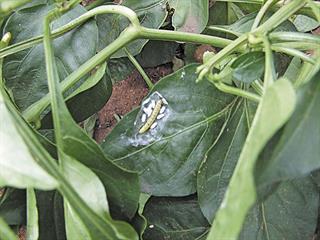
With other pests, they can at least reduce their numbers, possibly to tolerable levels. The diamondback moth and leaf miner are two examples of pests that can be completely controlled by parasitoids.
This is not the case with aphids, certainly in the case of the species that feeds on cabbages, Brevicoryne brassicae. The problem is compounded by this specific aphid being more active in winter when the insects that prey on it are less active.
The parasitoid injects a single egg into an aphid large enough to sustain its larva.
Knowing that an adult wasp develops from inside an aphid gives an idea of just how tiny these parasitoids are. The cocoon is round, hard and silvery-grey. You will usually find clusters of these wherever aphids have been active for a time. However, there will also invariably be plenty of ‘healthy’ aphids present as well.
The ladybird beetle is a more effective predator than the parasitic wasp. The adults and their larvae consume vast numbers of aphids in a day. Lacewing flies also do good work, but are usually not plentiful. The same goes for hoverflies, whose greenish larvae are actually maggots that feed on aphids. These all contribute to reducing aphid numbers but seldom eliminate the pest.
In the case of aphids, therefore, an insecticide may have to be used. Make sure it does not harm these beneficial insects – they still have a role to play! They seek out aphids in the nooks and crannies where chemicals cannot reach.
If you are producing organic lettuce, you can tolerate a small aphid population. Beneficial insects should be able to bring the population almost down to zero before harvest. However, this is provided that the aphids are not infected with a virus. Then you will have to spray. I have seen entire cabbage lands rendered virtually useless by such a virus. (This invaded due to a neighbour’s negligence, incidentally.)
Whitefly
Whitefly on tomatoes and other crops can be controlled by Encarsia formosa. This parasitoid lays an egg in the whitefly pupa and destroys many more pupae by puncturing them and sucking out the fluid. I have used them on more than one occasion, saving me from having to spray. But as with aphids, if there is any chance that whitefly-transmitted viruses are in the area, more stringent measures must be taken straightaway.
Integrated pest management (IPM) offers many benefits, but requires diligence. Inspect crops frequently, get to know which beneficial insects can control the pest, and learn the safe ratio of beneficial insect to pest. The Internet is useful in this regard.
A number of beneficial insects are available for purchase in South Africa. One of my clients buys parasitoids to control thrips and mealybug in his pepper tunnels.
A way to save money
The financial benefits of IPM are certainly worth the effort.Despite this, South African farmers lag far behind their counterparts in countries such as Kenya. Perhaps this is not surprising; Kenya exports much of its produce to the EU, which is strict about chemical residues, and farmers have been forced to practise IPM. Not a bad thing, perhaps!













